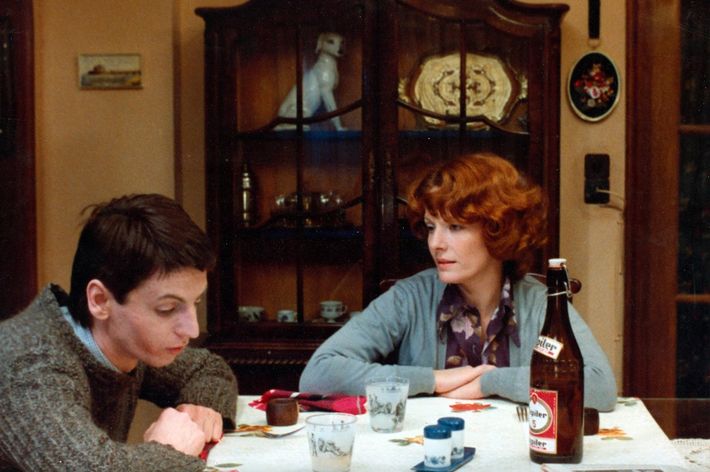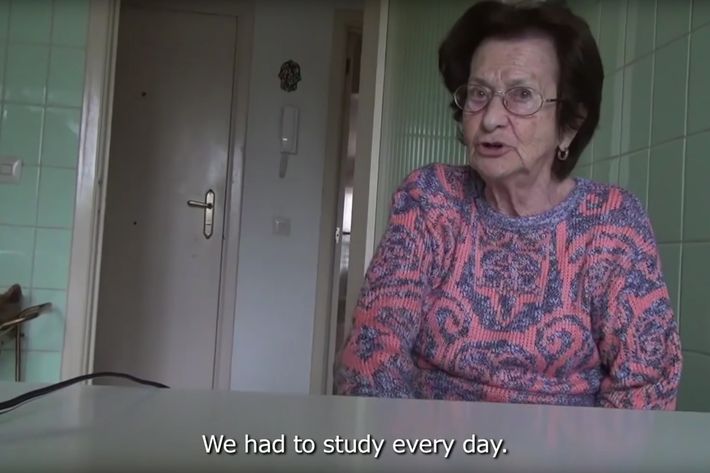
Chantal Akerman’s first short film was called Saute Ma Ville, which means, roughly, “blow up my town.” She made it when she was 18. She began that year of her life in a Belgian film school, but dropped out after a few months, figuring she could make better films on her own. She was not wrong. The precocious teenage Akerman financed that debut short herself, according to the film scholar Ivone Margulies, partially by “selling three-dollar shares on the diamond exchange in Antwerp.” And she starred in it, too: The 13-minute Saute Ma Ville follows a clownishly charismatic Akerman as she performs a number of domestic tasks with a sloppy, chaotic glee — Chaplin as madwoman in the attic. She’s electrifying to watch, but the film has a disturbing undertone that builds as it progresses. By the end, she has taped up the doors to her apartment, a task she completes with an eerie smile. In the final scene — a kind of DIY homage to her then-favorite film, Godard’s Pierrot Le Fou — she lights a piece of paper on fire, cranks up the gas on the stove, and puts her face to rest uncomfortably close to the burner. Only after the screen has gone black do we hear the explosion we’ve been dreading.
I saw Saute Ma Ville when I was 20. It is not hyperbolic to say that it changed my life. It was one of the only films I’d been shown in film school made by a woman — let alone a teenage girl, made at a time when there were considerably more barriers to getting your artistic voice heard as a young person. I was bowled over by the simple fact that we were sitting there, in a film class, still discussing a film that an 18-year-old girl had made 40 years before. I loved Saute Ma Ville — its rhythm, its irreverence, its sense of anarchy. I loved the way it blended comedy with unease. I had spent my first two years of film school feeling increasingly alienated from my professors and my classmates and the more traditional movies they wanted to make; everything I wrote seemed too strange, too personal. Saute Ma Ville and the rest of Akerman’s early films jolted me awake, gave me permission. They felt like handwritten notes from another alienated young woman, sent across generations, saying, “Yes, you can do this, too.”
Akerman’s films are largely about space, time, and, I’d venture to say, a particularly feminine sense of isolation, displacement, and ambivalence. In one of the best ones, 1977’s News From Home, she films strangers on the unfamiliar streets of New York (she moved here for a couple years in her early 20s, from 1971 to 1972) while reading aloud letters from her mother back in Belgium (an Auschwitz survivor who passed away last year and was the subject of her latest film, No Home Movie.) News From Home is a visual poem about loneliness and homesickness, but also about the ecstatic curiosity of an anonymous person in an unfamiliar city. A more recent work, 2006’s La Bas, is formally similar, combining footage she shot while staying alone in Tel Aviv with audio of her own thoughts and the diary entries of a deceased aunt. In the oddly hypnotic Hotel Monterey, Akerman’s camera wanders the hallways of a shoddy, desolate Manhattan hotel, finding compositional beauty in empty hallways and abandoned corridors. Akerman once said she liked to film the “images between the images” in more traditional narrative films. You are, of course, welcome to find her way of seeing boring — plenty of people have. But acquiring a taste for her films is like committing to a practice of meditation: a “boredom” that can quite literally rewire the brain.
Akerman’s best-known films (like the early film essay Je Tu Il Elle or the more traditionally structured Les Rendez-vous d’Anna) are often about women alone, a topic that still — nearly five decades after her debut as a filmmaker — makes plenty of people uncomfortable. There is a double standard still in place: A man sitting alone in a restaurant or a bar is perceived as mysterious, brooding, lost in thought; a woman sitting alone in the same place is perceived as jilted, lonely, yearning for a companion. We teach women to be more self-conscious about their solitude than men, but an artist needs to feel comfortable in solitude in order to think, create, and innovate. This is a subtle but huge reason why we still have too few female artists.
I spent the rest of my time as an undergrad watching every Chantal Akerman film I could get my hands on — and shamelessly ripping them off. I started renting one of my university’s last surviving Bolex H16 cameras; it had a busted door that I had to duct-tape shut so as not to expose the film. It would have been easier to shoot digitally, but I wanted my weird personal-essay films to look as much like Akerman’s as possible. (In one particularly on-the-nose short, I spelled out a Charlotte Brontë quote in Campbell’s alphabet-soup letters; unexpectedly, fishing through ten cans of acidic tomato broth stung my and my actress’s hands so badly that we spent the rest of the afternoon soaking them in ice water.) I started pouring my own part-time earnings into my projects, just like her. There was only one place left in the D.C. area that would transfer old black-and-white 16mm film onto digital video, so every couple weeks I’d ride the subway to the end of the line, take a creepy shortcut through a small cemetery in suburban Maryland, and drop off my reels. These journeys felt ritualistic and important; I made them alone. I felt, rather presumptuously, like a steward of a dying breed.
I eventually abandoned filmmaking for an even more solitary profession. But the truth is that Akerman’s films, with their monastic but often strangely bemused heroines, taught me how to get comfortable spending time alone. They taught me not just how to endure solitude, but to find an odd joy in it. I see so clearly now that they taught me the first step in making a life as a writer.
***

A lot of the obituaries of Chantal Akerman have called her a “feminist filmmaker,” or lauded her for telling the untold stories of women’s lives. And I suppose I haven’t said much to complicate that narrative, so here I should let Chantal have some say in the matter: “I think it is poor and limiting to think of my films as feminist,” she once said in an interview. “You wouldn’t say of a Fellini film that it’s a male film … When people say there is a feminist film language, it’s like they’re saying there is only one way for women to express themselves.” (She’s had arguably harsher words when people have tried to label her films “lesbian” or “LGBTQ”; she was once quoted saying, “I will never permit a film of mine to be shown in a gay film festival.”)
The Akerman film most often stuck with the “feminist” prefix is, indisputably, her masterpiece, Jeanne Dielman, 23 Quai du Commerce, 1080 Bruxelles. She made it when she was 25, the same age Orson Welles was when he made Citizen Kane. In it, we watch the titular, emotionally enigmatic widow/secret prostitute (an immaculately coiffed Delphine Seyrig) perform a number of household tasks in what seems like real time: She makes coffee, peels potatoes, and — what’s this? — receives payment from her john, all with the same detached affect. It’s a study in the way filmic time passes, a meditation on what we define as “drama,” an homage to the invisible labor of the housewife. It is bizarre and beautiful and absolutely riveting. It has also aged better than the sort of stereotypically one-dimensional second-wave feminist art that taught us to perceive the domestic sphere as nothing but a prison and to see women like Jeanne as helpless victims of the patriarchy. Akerman sees something infinitely more complex in her heroine. Jeanne Dielman is as much a celebration of household ritual as it is a condemnation. She sees daily routine not as a prison so much as a kind of gorgeous and elaborate dance.
I have struggled with this, in my admiration of Akerman: How can I honor her wish to be perceived as something more universal than “a female filmmaker” while still acknowledging the fact that something in her films spoke to me specifically as a woman and as a feminist? I don’t have an easy answer to that question, but I am grateful for its messiness. The older I get, the more I realize that the women who have helped me arrive at a personal definition of feminism are more often than not the ones who have poked and prodded at the term, refused its simplest slogans, challenged its cleanest borders. I find enough peace in the way Ivone Margulies puts it, writing about Jeanne, a figure onto which Akerman has piled “layers of signification that include but are not restricted to the feminist reading.”
The truth is that Akerman was prickly, and parts of her legacy will always remain so. It’s widely believed that her early work was her best (I haven’t seen all of her late films, but I’d suspect this is true), and I’m sure it wasn’t easy on her to know that most people thought she could never top the movie she made when she was 25. (That wasn’t easy on Welles, either.) And the facts that have trickled out about her death and the last year of her life have been bleak, dismaying, almost unspeakably tragic. No Home Movie, which interrogates her dying mother’s experiences Auschwitz, seems to have taken a heavy emotional toll on her; friends told the Times that she had been “in a dark emotional state” since her mother’s passing. The French paper Le Monde has reported her death as a suicide, though the official cause has not yet been released. Regardless, the ending to Saute Ma Ville has taken on a haunting new meaning. A film that had once been such a source of joy for me was, yesterday, too difficult to bear.
***

I can’t end an homage to an artist I admire on such a bleak note, so here is a postscript, written in the spirit of Chantal Akerman, who taught me so much about the power of the personal, the enormity of minor things, the destabilizing force of intimate detail.
About a year ago, I finally made a friend who is as much of an Akerman nut as I am. Her name is Anna, and when we met she was working on an M.A. thesis that was partially about some of Akerman’s documentaries. I remember the car ride when we both started geeking out about her for the first time, and we were so annoying about it that I’m surprised the other passengers did not throw us from the moving vehicle. Our Akerman fandom soon became the crux of our friendship, something we would joke about. We now accompany each other to the movies that are too long or slow for other people to want to see with us. Earlier this year, we organized a screening of Jeanne Dielman on a projector in our friends’ living room; one of the hosts took a long nap and marveled when she came back in the room that she had not missed anything at all. We laughed.
Last week, Anna emailed me when she realized we forgot to get tickets to the New York Film Festival’s Wednesday night screening of No Home Movie (subject line: “OMG WE FUCKED UP”). There were still tickets for Thursday night, but she was headed out of town that morning. “I am seriously tempted to change my flight but I know that is ridiculous,” she said. I told her that it was, but that I was honored to be friends with a person who would even consider changing a flight for a Chantal Akerman–related reason. The exchange made me think, as I did yesterday, of my favorite Akerman quote, which she told an interviewer in 1982. I’ve written it down in so many notebooks that I know it by heart. “I haven’t tried to find a compromise between myself and others,” it goes. “I have thought that the more particular I am, the more I address the general.”

